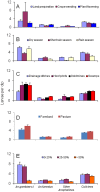Anopheline larval habitats seasonality and species distribution: a prerequisite for effective targeted larval habitats control programmes
- PMID: 23272215
- PMCID: PMC3525533
- DOI: 10.1371/journal.pone.0052084
Anopheline larval habitats seasonality and species distribution: a prerequisite for effective targeted larval habitats control programmes
Abstract
Background: Larval control is of paramount importance in the reduction of malaria vector abundance and subsequent disease transmission reduction. Understanding larval habitat succession and its ecology in different land use managements and cropping systems can give an insight for effective larval source management practices. This study investigated larval habitat succession and ecological parameters which influence larval abundance in malaria epidemic prone areas of western Kenya.
Methods and findings: A total of 51 aquatic habitats positive for anopheline larvae were surveyed and visited once a week for a period of 85 weeks in succession. Habitats were selected and identified. Mosquito larval species, physico-chemical parameters, habitat size, grass cover, crop cycle and distance to nearest house were recorded. Polymerase chain reaction revealed that An. gambiae s.l was the most dominant vector species comprised of An.gambiae s.s (77.60%) and An.arabiensis (18.34%), the remaining 4.06% had no amplification by polymerase chain reaction. Physico-chemical parameters and habitat size significantly influenced abundance of An. gambiae s.s (P = 0.024) and An. arabiensis (P = 0.002) larvae. Further, larval species abundance was influenced by crop cycle (P≤0.001), grass cover (P≤0.001), while distance to nearest houses significantly influenced the abundance of mosquito species larvae (r = 0.920;P≤0.001). The number of predator species influenced mosquito larval abundance in different habitat types. Crop weeding significantly influenced with the abundance of An.gambiae s.l (P≤0.001) when preceded with fertilizer application. Significantly higher anopheline larval abundance was recorded in habitats in pasture compared to farmland (P = 0.002). When habitat stability and habitat types were considered, hoof print were the most productive followed by disused goldmines.
Conclusion: These findings suggest that implementation of effective larval control programme should be targeted with larval habitats succession information when larval habitats are fewer and manageable. Crop cycles and distance from habitats to household should be considered as effective information in planning larval control.
Conflict of interest statement
Figures






References
-
- Afrane YA, Lawson BW, Githeko AK, Yan G (2005) Effects of microclimatic changes caused by land use and land cover on duration of gonotrophic cycles of Anopheles gambiae (Diptera: Culicidae) in western Kenya highlands. J Med Entomol 42: 974–980. - PubMed
-
- Afrane YA, Zhou G, Lawson BW, Githeko AK, Yan G (2006) Effects of microclimatic changes caused by deforestation on the survivorship and reproductive fitness of Anopheles gambiae in western Kenya highlands. Am J Trop Med Hyg 74: 772–778. - PubMed
-
- Balls MJ, Bodker R, Thomas CJ, Kisinza W, Msangeni HA, et al. (2004) Effect of topography on the risk of malaria infection in the Usambara Mountains, Tanzania. Trans R Soc Trop Med Hyg 98: 400–408. - PubMed
-
- Bodker R, Akida J, Shayo D, Kisinza W, Msangeni HA, et al. (2003) Relationship between altitude and intensity of malaria transmission in the Usambara Mountains, Tanzania. J Med Entomol 40: 706–717. - PubMed
-
- Bodker R, Msangeni HA, Kisinza W, Lindsay SW (2006) Relationship between the intensity of exposure to malaria parasites and infection in the Usambara Mountains, Tanzania. Am J Trop Med Hyg 74: 716–723. - PubMed
Publication types
MeSH terms
Grants and funding
LinkOut - more resources
Full Text Sources
Other Literature Sources

